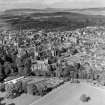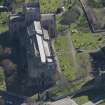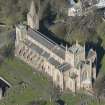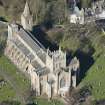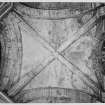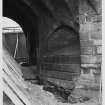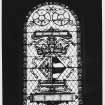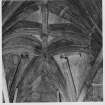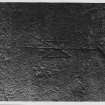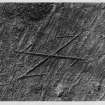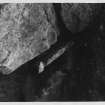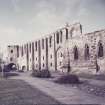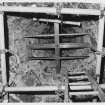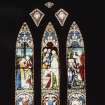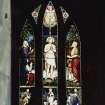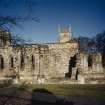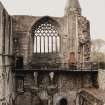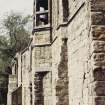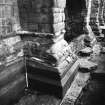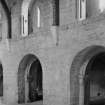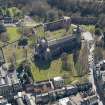Pricing Change
New pricing for orders of material from this site will come into place shortly. Charges for supply of digital images, digitisation on demand, prints and licensing will be altered.
Dunfermline, St Margaret's Street, Dunfermline Abbey, Palace And New Abbey Parish Church
Abbey (12th Century), Nave (12th Century), Parish Church (19th Century), War Memorial(S) (20th Century)
Site Name Dunfermline, St Margaret's Street, Dunfermline Abbey, Palace And New Abbey Parish Church
Classification Abbey (12th Century), Nave (12th Century), Parish Church (19th Century), War Memorial(S) (20th Century)
Alternative Name(s) Abbot Street; Maygate; Monastery Street; St Catherine's Wynd; Boer War Memorial: War Memorial Chapel
Canmore ID 49315
Site Number NT08NE 1
NGR NT 08980 87310
NGR Description NT 08964 87310 and NT 08996 87309
Datum OSGB36 - NGR
Permalink http://canmore.org.uk/site/49315
First 100 images shown. See the Collections panel (below) for a link to all digital images.
- Council Fife
- Parish Dunfermline
- Former Region Fife
- Former District Dunfermline
- Former County Fife
NT08NE 1.00 08964 87310 and 08996 87309
NT08NE 1.01 c.0907 8730 Entrance Gateways and Precinct Wall
NT08NE 1.02 08940 87254 The Pends (Gatehouse)
NT08NE 1.03 0918 8710 Gate
NT08NE 1.04 0896 8737 Gate
NT08NE 1.05 0894 8734 Gate
NT08NE 1.06 08919 87261 Palace and Kitchen
NT08NE 1.07 08963 87261 Frater Hall
NT08NE 1.08 09036 87379 Abbot's House
NT08NE 1.09 0896 8728 Cloisters
NT08NE 1.10 090 871 Mill
NT08NE 1.11 0895 8721 Barn; Stables; Mill
NT08NE 1.12 0903 8737 Trial Excavations; Burial Ground; Culvert
NT08NE 1.13 089 872 Watching Brief
NT08NE 1.14 0903 8731 Chapel
NT08NE 1.15 0904 8128 Cemetery
NT08NE 1.16 08994 87243 Dorter and Reredorter
NT08NE 1.17 08947 87346 New Abbey Parish Church, Boundary Wall and Railings
NT08NE 1.18 09079 87308 New Abbey Parish Church, East Gateway
NT08NE 1.19 08964 87377 New Abbey Parish Church, North West Gateway
NT08NE 1.20 08937 87310 New Abbey Parish Church, West Gateway
NT08NE 1.21 09068 87320 New Abbey Parish Church, Gatehouse.
(NT 0898 8731) Abbey (NR) (remains of)
OS 6" map (1967)
The remains of the Benedictine Abbey founded by David I in 1128 overlying the foundations of the Church of the Holy Trinity, founded by Queen Margaret c. 1070, in which a priory was apparently established. The plan of Queen Margaret's church is outlined on the floor of the nave of the later church and parts of the foundation can be seen through gratings. The plan, recovered by excavation about 1916, consists of a nave with a square set tower. A choir and apse appear to have been added at a slight later date and on a slightly different axis.
Of the Benedictine Abbey, the nave of the church, also dedicated to the Holy Trinity, remains, now used as a vestibule to the parish church which was built in 1819 on the site of the choir, transepts and crossing tower of its predecessor. The remains of a 13th century chapel, dedicated to St Margaret, which was attached to the E end of the Abbey Church, still survive at the E end of the modern church.
Of the conventual buildings only the under-buildings of the frater, dorter and rere-dorter remain (NT08NE 1.07) to the S of the graveyard which now occupies the site of the cloister (NT08NE 1.09) and most of
the E range. These are all 14th century, the earlier buildings having been destroyed in 1303 by Edward I who spared only the church.
On the south, these buildings are separated by a terrace, crossed by a late 14th century gatehouse (NT08NE 1.02) from the kitchens and the guest-house. These also are 14th century although in the late 16th or early 17th century's the guest-house was raised in height, substantially altered and transformed into a royal palace (NT08NE 1.6). The 16th century Abbot's House (NT08NE 1.08) is now occupied as tenements.
The Abbey precinct (NT08NE 1.01 and NT08NE 03 -05) was surrounded by a wall 12' high and 4' - 5' thick with ports and posterns, enclosing an area of 360 acres. The Abbey mill was about NT 0903 8719 (NT08NE 1.10).
RCAHMS 1933; D E Easson 1957; E Henderson 1879
The Abbey Church is still in use as a vestibule to the parish church.
Visited by OS (DWR) 18 February 1974
Reports on excavations at Dunfermline Abbey in 1975 and 1977, the latter exposing what may be part of the south wall of the early church.
T M Robertson, G H Williams, G Haggerty and N Reynolds 1982
Correspondence relating to the discovery of stone sarcophagi in 1847, and correspondence, drawings and photographs relating to P MacGregor Chalmer's 1916 excavations are held in the National Archives of Scotland (MW/1/901).
Information from RCAHMS (IF), 19 August 2002.
NT 089 873 A watching brief was undertaken in February 2005 during the excavation of a trench to repair a drain serving the abbey toilets, running from the E wall of the abbey, underneath a tarmac path to the S of St Margaret's Shrine, and joining the main sewage system in the nearby street. The excavations revealed a site that had obviously been disturbed at least four times in the past in order to provide drainage, water and lighting facilities to the early 19th-century abbey. Nothing of archaeological interest was discovered.
Archive to be deposited in NMRS.
Sponsors: HS A, Kilmadock Development Trust.
S Hogg 2005
NT08NE 1.00 08964 87310 and 08996 87309
Architects:
William Burn 1818
(Plan by William Stark for a gallery)
Sir Robert Rowand Anderson 1892 (Steps and entrance gates - decoration of interior of Parish Church).
Hon. Dashwood Preston Bruce by Noble General Bruce by Foley
NMRS Print Room
W Schomberg Scott Photograph Collection Acc No 1997/39
7 prints, 2 exterior views.
REFERENCE
SCOTTISH RECORD OFFICE
Tack by the commandator and convent to Patrick Buttar of Gormack and others of the Kirks of Muling and Stratherdill etc. In consideration of ?1050 marks paid to them for the reparation and "bigging" of this Abbey and specially for the W quarter of the cloister now in bigging and to be thekyt with lead.
1520
GD93/44
A note concerning the replacement of diamond-shaped panes of glass in many of the windows of the abbey and the making of some new windows in the rooms. James Hendersone to do the work.
1654
GD28/1705
Estimates for the repair of windows and a report on their ruinous state from James Henderson, glazier.
1656
GD28/1731
Account for glasswork. (?25.10.1 Scots). Glazier: James Henderson.
1660
GD28/1761
Receipt for slater work. (?12 Scots). Slater: James Aeson.
1663
GD28/1781
Receipt for glass work. (?23.1.0 Scots). Glazier: James Henderson.
1663
GD28/1782
Receipt for wright work. (?5.16.0 Scots). Wright: Walter Potter
1665
GD28/1866
Receipt for wright work. (?700 Scots). Wright: James Baine.
1665
GD28/1867
Receipt for slater work. (?37.5.4 Scots). Slater: James Andersone.
1665
GD28/1878
Account for demolishing and then rebuilding the tofall (a 'lean-to) in the Abbey. Receipt by John and Walter Pottir for ?7.0.0 Scots
1665
GD28/1880
Discharge for work done at the Abbey in the name of Lord Yester by David and John Cuninghame, smiths. (?65.8.0)
1696
GD28/2236
Discharge for wright work done at the Abbey by James Wilson. (?19 Scots)
1696
GD28/2237
Discharge for slater work done at the Abbey in the name of Lord Yester by William Easone. (?45.5.0 Scots).
1696
GD28/2238
The gatehouse and turnpike of the baylerie house of the Abbey. Discharge for wright work done by John Mackie and granted to Lord Yester's factor.
1696
GD28/2247
Discharged account by John Henderson, glazier, for work done by him. It amounts to ?10.13.0 and was paid by the Earl of Tweeddale's factor.
1666
GD28/2407
Discharge for wright work done at the Abbey in the name of Lord Yester by Hew Tait. (?47.16.0 Scots).
1696
GD28/2239
Dunfemrline Abbey. Letter from David Wilson, provost of Dunfermline, referring to discovery of bones wich 'may be part of the remains of the ancient Royal Family of Scotland'.
1820, June 24
E342/34
Note from Miss Adam to Mr Loch.
She explains how work on the site uncovered the body of Robert the Bruce.
1818
GD160/Box98
Plans: Stored (1941) at 163 Harle Drive, Mile Hill, London NW7, plans elevations & sections of doors window Mr D by John C. Todd 1931.
In the National Library of Scotland, Vol.I., No.41, of Water Colour Sketches by Thomas Brown, Advocate, is a view of part of the Abbey buildings. Reference "Adv. Mss. 34.8.1-3".
See under "Water Colour Sketches, Series of, by Thomas Brown, Advocate."
The National Library of Scotland, Edinburgh, contains, among the 'Uncatalgued Mss of General Hutton', and numbered 9 and 10, Vol.1 several rather eneffective Views (one in colour) of Dunfermline Abbey; a Plan and section of the Abbey Church, drawn in pencil tot he scale of three quarters of an inch to ten feet as it was prior to the 19th August (year not given, but may be 1812), on Page 12; and numbered 13, Vol.1 Plan and Reference by Alex. Morton, Builder, 1812.
The Plan and Section on Page 12 shew the Abbey Church prior to the time when the part of the Tower fell.
National Library of Soctland: Scots Magazine, March 1810 - text and photographs.
For details of excavation archive by Scotia Archaeology Limited in 1993 see ARCHAEOLOGY
Online Gallery (1306 - 1329)
The year 2014 sees the 700th anniversary of the Battle of Bannockburn, in which the army of Robert I of Scotland defeated that of Edward II of England. The battle marked a major turning point in the long, drawn-out struggle of the Wars of Independence.
The Wars have had a lasting influence upon all the nations of the United Kingdom and upon the national story. Each age has seen fit to commemorate the events in its own way: through the perpetuation of the genuine historical associations of buildings and places and also through the endowment of others with improbable or fanciful traditions. Where past generations allowed its historic buildings to decay and disappear, later generations began to value and actively preserve these for their associations. Where an event lacked a tangible reminder, as at Kinghorn where Alexander III was killed in a riding accident, a commemorative monument would be erected to act as a focus. The Wars of Independence predate the fashion for accurate portraiture: the weathered, generic military effigy of Sir James Douglas is one of the few to survive in Scotland. Later centuries saw a need and supplied it by a crowd of images of its historic heroes, William Wallace and Robert the Bruce, each depicted according to contemporary taste and imagination. The opening of the new heritage centre at Bannockburn takes this into a new dimension, through the use of three-dimensional, digital technology.
RCAHMS Collections hold many images of these buildings and locations from battlefields, castles and churches, to the many commemorative monuments erected in later years. This gallery highlights a selection of these, including antiquarian sketches, photographic and drawn surveys, and architectural designs.
Field Visit (March 1929)
Dunfermline Abbey.
The Benedictine Abbey of Dunfermline stands on an eminence which falls steeply on the south and west to the course of the Tower Burn. The church, which is the most northerly of the buildings, lies on the highest part of the site and is superimposed upon the remains of an earlier church, dedicated to the Holy Trinity and founded by Queen Margaret soon after her marriage with Malcolm III (1), an event which is variously dated between 1067 and 1070.
The foundations of the older building were discovered beneath the existing nave by the late Dr. Macgregor Chalmers in 1916, and were planned by H.M. Office of Works in the following year. Fig. 228 [FID 89/32] has been prepared from the survey then made. The outline of Queen Margaret's church is now traced on the floor of the nave, where certain parts of its foundations can be seen through gratings. On plan it had consisted of a nave with a square western tower, and an oblong choir ending in an apse. Choir and apse were evidently an addition to nave and tower, for the axial lines do not coincide, and the foundations of the choir are not uniform with those of the nave. Further, the provision of an archway between choir and apse points rather to Roman than to Celtic church-building practice. During the excavations three graves were exposed within the chancel and two others within the apsidal sanctuary. The great monastic church, dedicated in 1150 (2) was commenced in 1128 (3), when David I brought Geoffrey, the Prior, from Canterbury to be the first Abbot of Dunfermline (4). It was a fully developed cruciform structure with northand south aisles, western towers, and a tower at the crossing. It measured internally some 212 feet from east to west by 107 feet between the gables of the transepts. Nothing is now left of it except the nave, but this, although incomplete and to some extent modified, is one of the finest surviving examples of Scoto-Norman monastic architecture. In detail and lay-out it closely resembles Durham, which was begun in 1093 and finished by 1128. As at Durham, the east end was "parallel-apsed" and the nave arcades were eight bays in length, with the western bays opening into the undercrofts of the western towers.
In the 13th century David's Church was "enlarged by the construction of a nobler building (per nobilioris structurae fabricam fuerit augmentata)." So extensive indeed were the changes that the question arose whether there ought not to be a new consecration. The Papal decision, however, was that this was unnecessary, seeing that "the old walls, for the greater part remained in their original state" (5). The "old walls" were the existing walls of the nave, the improving and "augmenting" of the fabric being the reconstruction of the eastern part and the addition of the chapel of St. Margaret at the east end. The date of the Papal pronouncement is August 1249. As the remains of Queen Margaret and Malcolm Canmore were transferred to their new resting-place "in the choir beyond the high altar (in choro supramagno altare)” (6) in the following year, the date 1250 may be taken as that of the completion of the church.
[see RCAHMS 1933 No. 197, pp.106-121, for a full description of the abbey, conventual buildings, tombstones etc]
RCAHMS 1933, visited March 1929.
(1) Turgot, Vita Margaretae, cap. vii. Fordun attributes the foundation to King Malcolm or to Malcolm and Margaret (Chronica, V, cap. xx, xxxiv). In 1290 there was intimated a specified relaxation of penance to such as visited the "Church of St. Margaret, Dunfermline, on her feast." (Calendar of Papal Registers, i, p. 520). Locally, too, it was known as "Sant Margretis Kyrk." (Burgh Records of Dunfermline, ed. Erskine Beveridge, No. 45). (2) Chronicon Sanctae Crucis, p. 30. (3) Cf. Reg. de Dunfermelyn, No. 18. (4) John of Worcester, a contemporary, in Chronicon ex Chronic is (E.H.S.), vol. ii, p. 90. (5) Reg. de Dunfermelyn, No. 288. (6) Scotichronicon, X, cap. iii.
Field Visit (18 February 1974)
The Abbey Church is still in use as a vestibule to the parish church.
Visited by OS (DWR) 18 February 1974
Excavation (1975 - 1977)
Reports on excavations at Dunfermline Abbey in 1975 and 1977, the latter exposing what may be part of the south wall of the early church.
T M Robertson, G H Williams, G Haggerty and N Reynolds 1982
Publication Account (1987)
The great monastic church of Dunfermline was commenced in 1128 and completed in 1250. It was built over the foundations of an earlier church and took the form of a fully-developed cruciform structure similar, in lay-out and detail, to Durham Cathedral. The church measured 64.5 m from west to east and 32.5 m from north to south transept gables. Unfortunately only the nave of the medieval church survives, incomplete and somewhat modified, but this remains one of the finest examples of Scoto-Norman monastic architecture.
During the 13th century there was a major enlargement to the eastern end of the building, including the addition of a chapel to St Margaret at the east end. This work was completed in 1250. The choir was extended on the north side in the 14th century, probably by the addition of the Lady Aisle which was later demolished. In the nave three of the aisle windows and all the triforium windows were changed from Romanesque to Gothic. At this time the wall-head of the aisle appears to have been lowered. Towards the end of the 14th century the west gable was reconstructed from above the doorway. In the mid 15th century the north-west tower and the two adjoining bays of the nave were rebuilt The upper part of this tower, as it survives, appears to be the work of William Shaw, Master of Works to James VI from 1583 to his death in 1602.
The main body of the church appears to have been unsafe in 1563; in 1620 the vault of the south aisle was rebuilt and a few years later the aisle walls of the nave were strengthened by the introduction of the heavy buttresses which now form a major element in the composition.
During the 17th and 18th centuries the church suffered major damage. In 1672 the east part of the choir and the Lady Chapel were blown down and in 1716 the crossing fell. This remained ruinous for the next century and in 1819 the transepts were removed leaving only the nave of the medieval church. The south-west tower was damaged by lightning in 1807 and rebuilt in 1810.
The church should be considered as part of the whole monastic complex of which the Palace pends and Frater range survive in St Catherine's Wynd and Monastery Street and the Abbot's House in Maygate and Abbot Street.
Information from ‘Exploring Scotland’s Heritage: Fife and Tayside’, (1987).
Reference (19 August 2002)
Correspondence relating to the discovery of stone sarcophagi in 1847, and correspondence, drawings and photographs relating to P MacGregor Chalmer's 1916 excavations are held in the National Archives of Scotland (MW/1/901).
Information from RCAHMS (IF), 19 August 2002.
Watching Brief (February 2005)
NT 089 873 A watching brief was undertaken in February 2005 during the excavation of a trench to repair a drain serving the abbey toilets, running from the E wall of the abbey, underneath a tarmac path to the S of St Margaret's Shrine, and joining the main sewage system in the nearby street. The excavations revealed a site that had obviously been disturbed at least four times in the past in order to provide drainage, water and lighting facilities to the early 19th-century abbey. Nothing of archaeological interest was discovered.
Archive to be deposited in NMRS.
Sponsors: HS A, Kilmadock Development Trust.
S Hogg 2005
Watching Brief (25 February 2008 - 16 July 2008)
NT 0896 8731 Monitoring works were undertaken between 25 February–16 July 2008 in relation to the development of St Catherine’s Wynd and Monastery Street, next to Dunfermline Abbey. This entailed the repaving and landscaping of St Catherine’s Wynd and Monastery Street as well as the adjoining passage through The Pends. Additional works, such as the felling of trees on Monastery Street, placement of services and street lighting were also covered. Several significant archaeological features were uncovered and recorded. These features related to the extended structure of the Abbey and the Palace as well as the subsequent surrounding industry.
Archive: RCAHMS. Report: WoSAS
Funder: Fife Council Property Services
Alan Matthews (Rathmell Archaeology Limited), 2008
Also reported in Oasis (rathmell1-44431) 26 March 2013
Watching Brief (23 July 2012 - 30 July 2012)
NT 0897 8731 A watching brief was carried out, 23–30 July 2012, during the lifting of slumped floor slabs within the church. Two trenches were excavated to discover the cause of the subsidence. One trench contained a layer of sand over concrete. The second contained a limited amount of fine sand immediately below the paving. Below the sand was a deposit of fine silt which contained a noticeable area of collapse. The E–W orientation and size of the area, 1.95 x 1.35m, probably reflects the presence of a burial. The bone noted within this area is likely to be human, but perhaps belongs to earlier burials disturbed by the collapsing one.
Archive: RCAHMS (intended)
Funder: Historic Scotland
David Murray, Kirkdale Archaeology
2012





















![Engraving of part of Dunfermline Abbey showing side of abbey & square tower with archway below.
Titled: 'Dunbermline, Plate II,' with notes on history of building. [Adam de Cardonnell.]](http://i.rcahms.gov.uk/canmore/l/DP00094375.jpg)






















































































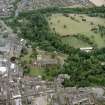



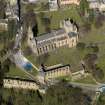






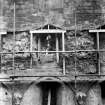

![Engraving of part of Dunfermline Abbey showing side of abbey & square tower with archway below.
Titled: 'Dunbermline, Plate II,' with notes on history of building. [Adam de Cardonnell.]](http://i.rcahms.gov.uk/canmore/s/DP00094375.jpg)



